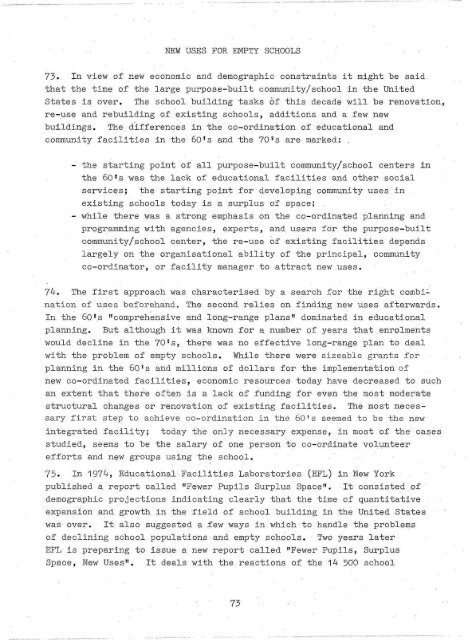BUILDING FOR SCHOOL AND COMMUNITY - Kennedy Bibliothek
BUILDING FOR SCHOOL AND COMMUNITY - Kennedy Bibliothek
BUILDING FOR SCHOOL AND COMMUNITY - Kennedy Bibliothek
You also want an ePaper? Increase the reach of your titles
YUMPU automatically turns print PDFs into web optimized ePapers that Google loves.
NEW USES <strong>FOR</strong> EMPTY <strong>SCHOOL</strong>S<br />
73. In view of new economic and demographic constraints it might be said<br />
that the time of the large purpose-built community/school in the United<br />
States is over. The school building tasks of this decade will be renovation,<br />
re-use and rebuilding of existing schools, additions and a few new<br />
buildings. The differences in the co-ordination of educational and<br />
community facilities in the 60's and the 70's are marked: ,<br />
- the starting point of all purpose-built community/school centers in<br />
the 60's was the lack of educational facilities and other social<br />
services; the starting point for developing community uses in<br />
existing schools today is a surplus of space;<br />
- while there was a strong emphasis on the co-ordinated planning and<br />
programming with agencies, experts, and users for the purpose-built<br />
community/school center, the re-use of existing facilities depends<br />
largely on the organisational ability of the principal, community<br />
co-ordinator, or facility manager to attract new uses.<br />
74. The first approach was characterised by a search for the right combination<br />
of uses beforehand. The second relies on finding new uses afterwards.<br />
In the 60's "comprehensive and long-range plans" dominated in educational<br />
planning. But although it was known for a number of years that enrolments<br />
would decline in the 70 8 s, there was no effective long-range plan to deal<br />
with the problem of empty schools. While there were sizeable grants for<br />
planning in the 60 ! s and millions of dollars for the implementation of<br />
new co-ordinated facilities, economic resources today have decreased to such<br />
an extent that there often is a lack of funding for even the most moderate<br />
structural changes or renovation of existing facilities. The most necessary<br />
first step to achieve co-ordination in the 60's seemed to be the new<br />
integrated facility; today the only necessary expense, in most of the cases<br />
studied, seems to be the salary of one person to co-ordinate volunteer<br />
efforts and new groups using the school.<br />
75. In 1974, Educational Facilities Laboratories (EFL) in New York<br />
published a report called "Fewer Pupils Surplus Space". It consisted of<br />
demographic projections indicating clearly that the time of quantitative<br />
expansion and growth in the field of school building in the United States<br />
was over. It also suggested a few ways in which to handle the problems<br />
of declining school populations and empty schools. Two years later<br />
EFL is preparing to issue a new report called "Fewer Pupils, Surplus<br />
Space, New Uses". It deals with the reactions of the 14 500 school<br />
73
















